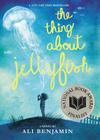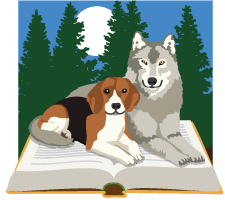Staff Picks
Last month, Jen and Sally’s picks were drawn from their recommendations at January’s Night In.
This month, they share the rest of the books from that evening.
|
| |
|
 |
|
|
|
|
 Jen Jen |
|

|
 |
The Thing About Jellyfish
by Ali Benjamin
This middle grade book would be a great choice for adult book groups! Suzy befriends Franny in elementary school and the two become best friends, but once puberty hits their friendship begins to change and then unravel. By the time Franny drowns, the two aren’t really friends anymore. Rather than face her grief about Franny’s death, Suzy focuses on the possibility that Franny was killed by a jellyfish sting. Suzy, who is drawn to science, does research on jellyfish and seeks out experts, including swimmer Diana Nyad, for help. Sometimes Suzy makes bad decisions, like any of us, but she is one of the most sympathetic characters I’ve come across. As an outsider, we can see that the dissolving friendship between Suzy and Franny isn’t necessarily anyone’s fault and yet, my heart ached for Suzy. There’s a lot of depth to this book and it has the potential to spark wonderful discussion.
|
| |
|

|
|
H is for Hawk
by Helen MacDonald
This may well be the best book I read last year. It’s a memoir, with three components woven beautifully together. The first component is that the author’s father drops dead unexpectedly while working as a photographer in London. The author is dealing with the shock and grief of that death. Second, throughout the book is a sort of mini biography of T.H. White, the author of Once and Future King. In addition to being a writer, White was a falconer. Early on, he trains a goshawk, one of the most difficult birds to train, and completely botches it. Additionally, White struggles to come to terms with his homosexuality and recovering from a childhood with an abusive father. The third component is that the author is also a falconer and like White, has decided to train to a goshawk. Unlike White, however, she does a beautiful job of it, despite the challenges. The goshawk she trains is Mabel. These three components are woven together perfectly. You can tell the author is also a poet because some of the passages are so beautiful that you find yourself re-reading sentences to soak up the beauty of the writing.
Editor’s note: Helen MacDonald will be reading at the Loft Literary Center in Minneapolis at 7:00 on April 14. The event is free, but tickets are required. For more information: loft.org/events
|
| |
|

|
|
Marvel and a Wonder
by Joe Meno
This book is set in 1995 on a farm in Indiana. A 16 year old boy being raised by his financially-challenged grandfather because his mother is struggling with drug addiction. The grandfather is unexpectedly gifted with a horse that has potential to pull them out of their dire financial straits. Unfortunately, the horse attracts the attention of some drug dealing brothers who steal and sell it. What I most liked about this book was that it felt as though its trajectory was completely its own, that the author was recording it rather than necessarily giving it direction. That being said, the story doesn’t always go the way you want or the way you think it should go. Not every thread is neatly tied up at the end, and yet I found it very satisfying. While nearly all the characters in the book are male, I think both men’s and women’s book groups would find a great deal to discuss in this book.
|
| |
|

|
|
Deep Down Dark
by Hector Tobar
One of my favorite authors and now indie bookstore owner, Ann Patchett, began raving about this book early on. My initial interest in reading it was to satisfy my own curiosity but as I read it, I began to realize that it would be a great book group pick. This is the non-fiction account of the 33 miners in Chile who were trapped in a mine and ultimately rescued. While I knew the general story and the outcome before starting the book, there were a lot of issues that I thought about for the first time while reading it. In an emergency situation like that in this book, is it the company’s responsibility or the government’s responsibility to spearhead a rescue? It depends on where in the world you are and it makes for a great discussion. Some issues in the book you’d expect: the physical deterioration of people trapped with very little food and no clean water. When a person survives an emergency situation, it’s expected that that person has the right to share the story in the aftermath. When 33 people survive an emergency situation, whose story is it to tell? Good question, it’s explored in here. We get a glimpse into the lives of these men, which at times can provide humor—for example, one of the miners has both a wife and a girlfriend—so who gets dibs on him? The text of this book is incredibly well written. I think the author did an excellent job developing trust with the miners which allowed for that.
|
| |
|

|
|
A Sudden Light
by Garth Stein
When Sally and I took a road trip to Chicago area last fall, we listened to this audio book together. When the first CD ended, there was a collective squeal and a scramble to get out disc #2. A Sudden Light is a gothic ghost story. In the summer of 1990, fourteen-year-old Trevor Riddell first visits Riddell House, an incredible mansion built from the spoils of a massive timber fortune. Trevor's bankrupt parents have begun a trial separation, and his father, Jones Riddell, has brought Trevor to Riddell House with a goal: to join forces with his sister, Serena, to dispatch Grandpa Samuel--who is flickering in and out of dementia--to a graduated living facility, sell off the house and property for development into tract housing for millionaires, divide up the profits, and live happily ever after. But Trevor soon discovers there's someone else living in Riddell House: a ghost with an agenda of his own. While the land holds tremendous value, it is also burdened by the final wishes of the family patriarch, Elijah, who mandated it be allowed to return to untamed forestland as a penance for the millions of trees harvested over the decades by the Riddell Timber Company. The ghost will not rest until Elijah's wish is fulfilled, and Trevor's willingness to face the past holds the key to his family's future. This is a multigenerational family saga, a historical novel, a ghost story, and the story of members of a contemporary family struggling to connect with each other. As he uncovers secrets of his family's past that are hidden deep within the house, guided by the whisperings of the ghost, Trevor discovers a legacy of family trauma and terrible guilt. This book is ultimately about redemption and it is loaded with issues to discuss in a book group.
|
| |
|

|
|
Stolen from the Garden
by William Swanson
This is the non-fiction account of the 1972 kidnapping of Virginia Piper. The Pipers were a wealthy family living in Orono, Minnesota and Virginia, or Ginny, was taken from her home and held for ransom. The asking was one million dollars, which was a huge ransom at the time. Against the authorities’ advice, Ginny’s husband Bobby got the money together, which meant taking out a loan, and followed the strange instructions to deliver the ransom, most of which involved him acting alone. While Bobby worked this out, Ginny was taken to a state park and chained to a tree. Five years after Ginny’s safe return, two criminals were indicted for the crime, but were they the real kidnappers? The author, Bill Swanson, is a lawyer and did a terrific job of thorough research resulting in a very readable book. The reader is left with a lot of questions and doubts about this case. I think a group could really sink its teeth into a number of issues raised in the book: wealth and high society, the aftermath of an event like this on the victim and her family, and of course, the criminal justice system.
|
| |
|

|
|
The Magician’s Lie
by Greer Macallister
The Magician’s Lie is a novel set in the early 1900s. The Amazing Arden is the most famous female illusionist of her day, best known for her trick of sawing a man in half on stage. One night in Waterloo, Iowa, she trades her usual saw for a fire ax. When Arden's husband is found dead beneath the stage later that night, suspicion arises: Is it a new version of the illusion, or a murder? A policeman, Virgil Holt, watching from the audience takes Arden into custody for questioning. Once he has secured her to a chair with six sets of handcuffs, she tells him her life story. She tells him about her childhood, her training to be a dancer, and everything else that has led to the present moment. Her story is amazing and the reader is never really sure if she’s a reliable narrator. You can bet I’m not telling! If you liked books like The Magician’s Assistant, Night Circus, or Water for Elephants, this is a book you will like. For book group discussion, there’s a lot about women’s roles, American life in the early 1900s, performance, magic, family, and friendship that would generate great discussion. I absolutely love this book.
|
| |
|
|
|
|
|
|
|
 Sally Sally |
|
 |
|
|
|
|
| |

|
|
Leaving Before the Rains Come
by Alexandra Fuller
Alexandra Fuller was born in England and raised in southern Africa during the wars in Rhodesia. Her first two memoirs, Don’t Lets go to the Dogs Tonight and Cocktail Hour Under the Tree of Forgetfulness were beloved by book groups, including ours. In them, she describes a way of life which is difficult for us to comprehend. Danger was a fact of everyday life, and the eccentricities of her parents were both entertaining and appalling.
While in her twenties and still living in Africa, Fuller met Charlie Ross, an American adventurer. Their first date was a river trip which included a pod of threatening hippos and an elephant charge. In spite of that, Fuller thought that marriage to Charlie would mean being anchored somehow, and different from the chaos of her early life. The couple moved to Wyoming, and were married for 20 tumultuous years. Leaving Before the Rains Come isn’t the story of the break-up of their marriage as much it is an examination of her past—growing up in Africa and the family which she left there. Fuller focuses on her father, a man who “regretted and nothing and wanted less, even after fighting harder and losing more than most people could bear.” Eventually, she comes to realize that we can’t depend on others to save us, but we each have to take responsibility for ourselves.
Fuller has a distinct voice and idiosyncratic way of writing. It’s poignant, it’s laugh-out-loud funny, and she is totally endearing. |
| |
|

|
|
All My Puny Sorrows
by Miriam Toews
This book broke my heart, but I wouldn’t have missed reading it.
Miriam Toews is a Canadian writer who is beloved in Canada but unfortunately, not well known in the United States. This book is semi-autobiographical fiction. Isn’t that an interesting contradiction! Toews wrote the book after the suicides of her father and sister.
The book centers around two sisters. Yolandi is a mess, She’s a so-so author who’s been divorced twice, is broke, and can barely keep up with her two kids, who are growing up too fast. Elf, on the other hand, was a musical prodigy. She’s an internationally acclaimed concert pianist, she has a beautiful home and a husband who loves her. And, for most of her life, she has wanted to die.
When Elf attempts suicide just before an international tour, Yolandi rushes to be with her and attempts to keep their family from falling apart. It all sounds horrible, doesn’t it? And yet it’s not. The writing is incredibly beautiful, and the humor is outrageous and laugh out loud funny.
The book is life-affirming even while exploring loss, the meaning of family and of life itself. Toews’ depiction of the mental health system in Canada is highly critical.
This novel isn’t for every group, but it would be an excellent choice for readers who want to engage with serious issues, and are ready to laugh along the way.
|
| |
|

|
|
What was Mine
by Helen Ross
The premise of this novel is simple. A seemingly ordinary woman, a divorced woman who cannot conceive a child, steals a baby from a shopping cart at IKEA—and gets away with it for 21 years. No one—family, co-workers, friends, the daughter she kidnapped—has any idea. It’s clear almost from the beginning of the book that eventually Lucy’s secret is revealed. When Mia discovers the truth, she tentatively begins a relationship with her birth mother, while Lucy flees to China to avoid prosecution.
Some of the book is told in Lucy’s voice, but other people involved also narrate chapters—her daughter Mia, Mia’s biological parents, Lucy’s ex-husband, and a number of other characters. This has the effect of allowing the reader to hear the damage Lucy did to many people.
It’s a story of loss, but also of hope, and an examination of the ways many lives can be altered by one impetuous act. Many characters in the book lost “what was mine.” The book offers groups an opportunity to reflect on the meaning of motherhood, and the ways ordinary people cope with the unthinkable.
|
| |
|

|
|
The Song of Hartgrove Hall
by Natasha Solomon
This novel was my favorite of the books I read for Night In. How can you not immediately be drawn into a book with the opening line “Edie sang at her own funeral”? The book begins when three young men and their father return to the family estate in Dorset after WWII. Their home, Hartgrove Hall, is in disrepair after being occupied by the army during the war. Money for the needed repairs isn’t there, and the style of life they once led is disappearing. I thought at first that the story would be similar to Downton Abbey, but it’s uniquely its own. Fox, the youngest son, is a collector of songs, tracking down authentic folk tunes. He eventually becomes a composer and conductor and Song of Hartgrove Hall is the title of a symphony he writes. The book is full of music—Edie is a singer, Fox’s grandson is a musical prodigy and Fox’s friends are all involved in music in various ways.
The Song of Hartgrove Hall is a wonderful story about family, the power of music, betrayal, seeking forgiveness, and hope. It’s a powerful story, beautifully told.
This is the book for a group which wants a good story with many aspects for discussion. |
| |
|
|
|
|
|
| |
|
|
|
|

Ann |
|
 |
|
The Aviator's Wife
by Melanie Benjamin
I enjoyed The Aviator's Wife for many reasons. This work of historical fiction has many layers. It is the story of Charles Lindbergh's historic flight, how Charles and Anne's lives were impacted, and what they experienced emotionally. It is also the story of the Lindbergh's complicated marriage. The events of American life from the late 1920's to the mid-1960's make for an interesting backdrop. The Aviator's Wife is a fascinating story as well as tribute to Anne Morrow Lindbergh's amazing strengths and achievements.
|
| |
|
|
|
|
|
|
|

Gail |
|
 |
|
|
|
|
| |

|
|
Bottomland
by Michelle Hoover
This is a haunting story of a family living on an Iowa farm right after WWI. Two of the young girls in the family disappear one night with no message lift behind. Have they run away or been abducted? As the story unfolds we hear from several family members with their views on what has happened and perhaps why. There is great suspense until the end. The descriptions by the author of the farm, the war in France, the sweatshops and the boarding houses in Chicago are vivid. Not to be soon forgotten. |
| |
|

|
|
Chasing Chaos: My Decade in and Out of Humanitarian Aid
by Jessica Alexander
The author describes what it's like to travel to world disaster sites and be involved in the complex, challenging, nitty-gritty work of trying to make a difference in people's lives. This book is for anyone who wants to know where their contribution goes and how it's used. |
| |
|

|
|
English Creek
by Ivan Doig
This author, a favorite of many, died this past year. Doig says "writers of caliber can ground their work in specific land and lingo and yet be also writing of that larger country: Life,” and that is what he did with his writing. English Creek is part of the McCaskill trilogy, which also includes Dancing at the Rascal Fair and Ride with me, Mariah Montana. The Whistling Season, also by Doig, was on the New York Times bestseller list and is often compared to the writing of Wallace Stegner. You won't regret giving this author a try. |
| |
|

|
|
China Dolls
by Lisa See
Three young women from very different backgrounds come to San Francisco to find jobs at the 1938 World's Fair. The story follows the three through WWII as they become stars. Their dark secrets threaten to tear apart the bond they have made between them. The novel is historically accurate and gives a realistic portrayal of the life of Asians in the United States. See also wrote Snow Flower and The Secret Fan and Shanghai Girls.
|
| |
|
|
|
|
|
|
|

Hannah |
|
 |
|
|
|
|
| |
 |
|
Lila
by Marilynne Robinson
 I was hesitant to read this story of Reverend Ames' wife because I was afraid it would somehow lessen the impact of Gilead, one of my favorite novels. Most of Lila breaks your heart, but in the end it's about Grace, the peace that passes understanding. And Ames is drawn more clearly and dearly than ever. Reading Lila made me feel like I had done something important. I was hesitant to read this story of Reverend Ames' wife because I was afraid it would somehow lessen the impact of Gilead, one of my favorite novels. Most of Lila breaks your heart, but in the end it's about Grace, the peace that passes understanding. And Ames is drawn more clearly and dearly than ever. Reading Lila made me feel like I had done something important.
And reading Lila also made me pick up Gilead again. How can one author write in two such different voices, each so convincing?
|
| |
|

|
|
Appointment in Samarra
John O'Hara
I'll admit it: I was attracted by the cover design and because it's a Penguin Classic. And yes, sometimes you can judge a book that way! The novel is set in a small Pennsylvania town in 1930. It's an amazing portrait of a young man self destructing with the help of booze, over a 36 hour period starting on Christmas day. It's also a deftly drawn portrait of class distinctions and small town life, and one of the first novels to ever treat female sexuality with respectful attention. |
| |
|

|
|
A Confederacy of Dunces
by John Kennedy Toole
Long after Toole committed suicide, his mother convinced writer Walker Percy to read this novel, which she carried around in a shopping bag. Percy reluctantly agreed, fell in love with it, and got it published. It's a Pulitzer Prize winner, and a cult classic about strange characters running around New Orleans. It's very funny but also poignant. |
| |
|
|
|
|
|
| |
|
|
|
|

Liz
|
|

|
|
Landline
by Rainbow Rowell
In Landline, the main character, Georgie, goes through a major emotional rollercoaster, and takes the reader along for the ride. It’s the week before Christmas and she has just gotten the career opportunity she has been working towards for years. The only problem is that she must choose between this opportunity of a lifetime and spending Christmas with her family. During the week leading up to Christmas, her already strained relationship with her husband seems to be at a turning point. He seems to be avoiding her calls and the only way she can reach him is through their old landline telephone, except it isn’t her husband of the present that she seems to be talking to, but the one of almost twenty years ago, before they were married. Georgie is forced to seriously consider their relationship and whether she should use this strange connection to change past events, and in doing so, alter the entire course of their lives. This story really makes you realize just how complex relationships often are. I couldn't put it down!
|
| |
|
 |
|
Ape House
by Sara Gruen
Ape House is a story based on a very interesting subject, communication between species. It’s about six great apes, bonobos, which are part of a linguistics project. These six apes have become quite fluent in understanding spoken language and communicating through sign language with humans. They have an extremely strong bond with Isabel, the scientist who works with them. But one day, the lab where they live is bombed, and the apes are sold immediately, with no clue given as to where. Isabel is determined to find the apes and explores every possible source. As she hunts for the bonobos, she is exposed to some of the horrific results of great apes kept in captivity, such as animal testing, a lot of which is extremely unethical, and is even more determined to save the bonobos from such a fate. This is a very fascinating story, as it highlights both the amazing capacity which animals can have for communication and relationships with humans, but also the very unethical treatment which these same animals are often subject to by humans. |
| |
|
|
|
|
|
— page top —
|
|



 Jen
Jen Sally
Sally





